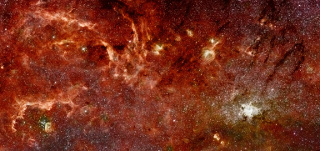In the infrared, things that are quite cool can be detected. In the far infrared you can look at things as cool as a few degrees Kelvin up to about 30 degrees Kelvin or 100 degrees Kelvin. In the mid-infrared you typically concentrate on warmer objects and in the near infrared warmer yet. The dust at the galactic center that I mentioned earlier is warmed to 10 degrees Kelvin.
Hubble-Spitzer Color Mosaic of the Galactic Center: This composite color infrared image of the center of our Milky Way Galaxy reveals a new population of massive stars and new details in complex structures in the hot ionised gas swirling around the central 300 light-years. This sweeping panorama is the sharpest infrared picture ever made of the Galactic core. It offers a nearby laboratory for how massive stars form and influence their environment in the often violent nuclear regions of other galaxies.
Credit: NASA, ESA and Q.D. Wang (University of Massachusetts, Amherst)
In the early days it was understood that there was a lot of dust in the galactic plane (in the plane of our Galaxy – the Milky Way) and in the zodiacal plane (the plane of the planets). It was becoming clear that dust seemed to be associated with star-forming regions and in the nuclei of some galaxies. It was emission from these dusty sources that drove the early infrared science.
The zodiacal dust, for example, reflects sunlight in diminishing amounts out to about a wavelength of 3 microns. But those dust grains absorb some of the sunlight as well, warming them up. Those warm particles of dust, which are several hundred degrees Kelvin, shine in infrared light at longer wavelengths. (That is, cold dust glows in the far infrared while warm dust glows in the near infrared.) Similarly, when you look at the plane of the Galaxy at longer and longer wavelengths, you detect dust heated by nearby stars and radiating at less than 100 degrees Kelvin.
At the time, we didn’t understand much about the concept of circumstellar disks or envelopes around stars, so our concentration was on the molecular clouds associated with star formation and the diffuse emission from the Galactic plane, the zodiacal plane, and also from what we were calling starburst galaxies, which appeared to be forming new stars quickly.
The coldest material in the Universe is about 3 degrees Kelvin. If there is no other source of heat, dust grains, for instance, will be heated to that temperature because of the cosmic background radiation left over from the Big Bang: that radiation has a temperature of just under 3 degrees Kelvin. Since we were searching for cold material, we also tried to look for the cosmic microwave background radiation, the glow of the Big Bang. That was an early emphasis. It wasn’t until the COBE mission that the so-called “3K blackbody emission” of the background associated with the Big Bang was unequivocally detected at a full range of infrared wavelengths.


